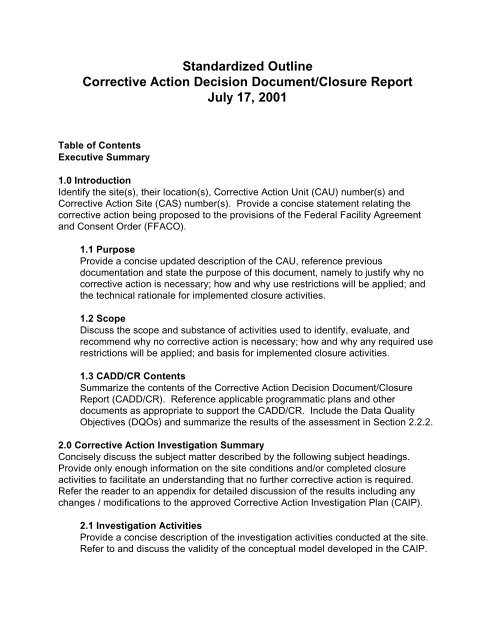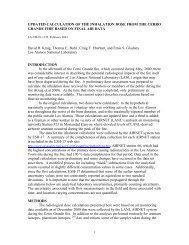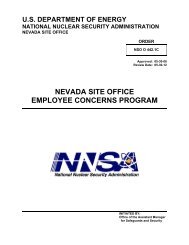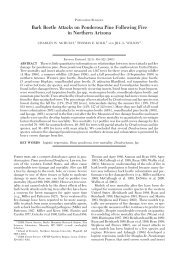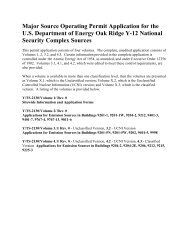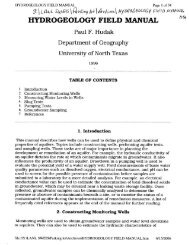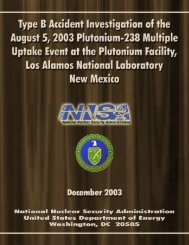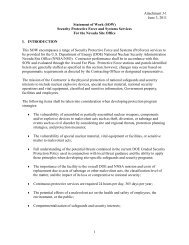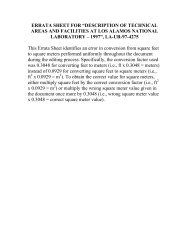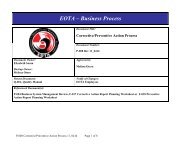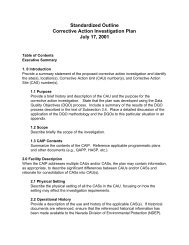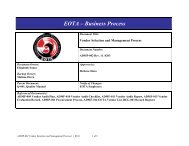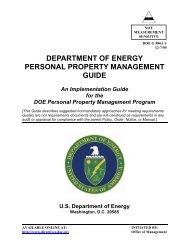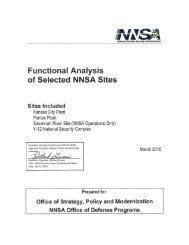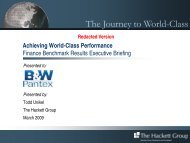Corrective Action Decision Document/Closure Report
Corrective Action Decision Document/Closure Report
Corrective Action Decision Document/Closure Report
Create successful ePaper yourself
Turn your PDF publications into a flip-book with our unique Google optimized e-Paper software.
Standardized Outline<strong>Corrective</strong> <strong>Action</strong> <strong>Decision</strong> <strong>Document</strong>/<strong>Closure</strong> <strong>Report</strong>July 17, 2001Table of ContentsExecutive Summary1.0 IntroductionIdentify the site(s), their location(s), <strong>Corrective</strong> <strong>Action</strong> Unit (CAU) number(s) and<strong>Corrective</strong> <strong>Action</strong> Site (CAS) number(s). Provide a concise statement relating thecorrective action being proposed to the provisions of the Federal Facility Agreementand Consent Order (FFACO).1.1 PurposeProvide a concise updated description of the CAU, reference previousdocumentation and state the purpose of this document, namely to justify why nocorrective action is necessary; how and why use restrictions will be applied; andthe technical rationale for implemented closure activities.1.2 ScopeDiscuss the scope and substance of activities used to identify, evaluate, andrecommend why no corrective action is necessary; how and why any required userestrictions will be applied; and basis for implemented closure activities.1.3 CADD/CR ContentsSummarize the contents of the <strong>Corrective</strong> <strong>Action</strong> <strong>Decision</strong> <strong>Document</strong>/<strong>Closure</strong><strong>Report</strong> (CADD/CR). Reference applicable programmatic plans and otherdocuments as appropriate to support the CADD/CR. Include the Data QualityObjectives (DQOs) and summarize the results of the assessment in Section 2.2.2.2.0 <strong>Corrective</strong> <strong>Action</strong> Investigation SummaryConcisely discuss the subject matter described by the following subject headings.Provide only enough information on the site conditions and/or completed closureactivities to facilitate an understanding that no further corrective action is required.Refer the reader to an appendix for detailed discussion of the results including anychanges / modifications to the approved <strong>Corrective</strong> <strong>Action</strong> Investigation Plan (CAIP).2.1 Investigation ActivitiesProvide a concise description of the investigation activities conducted at the site.Refer to and discuss the validity of the conceptual model developed in the CAIP.
CADD/CR Outline July 17, 2001 Page 22.2 Results2.2.1 Provide summary analytical data, plume concentration isopleth maps orgraphics that summarize the investigation results and affirm that basedon these results the CAU has been adequately characterized.2.2.2 An assessment as to whether or not the results from the CAIP meet thedata quality objectives must be included. The conceptual site modelmust be reconciled with the actual findings.2.3 Justification for No Further <strong>Action</strong>Justify why no further corrective action is to be performed at this site (e.g..,investigation activities determine that contaminants are below Preliminary <strong>Action</strong>Levels [PALs] stated in the approved CAIP and/or industrial PreliminaryRemediation Goals, or are determined not to present a risk to human health or theenvironment based on a site-specific risk assessment. If appropriate, provide asummary of any closure and verification activities that were performed). Providedetails on use restrictions (figures with coordinates, Use Restriction Forms, etc.)Based on the current U.S. Department of Energy Nevada Test Site (NTS)Resource Management Plan (RMP) for those sites on the NTS.3.0 RecommendationState that no further corrective action is required. Request NDEP issue a Notice ofCompletion for this CAU and the CAU be moved from Appendix III to Appendix IV of theFFACO.4.0 ReferencesProvide references for the sources of information used during the preparation of theCADD/CR.Appendices<strong>Corrective</strong> <strong>Action</strong> Investigation ResultsDiscuss the investigation and present the results. Minimize restating site history,etc.; refer to CAIP, as appropriate. Concisely discuss the field program, focusingon changes or deviations from the planned operation. Present and discuss theresults, quality assurance parameters and data validation results, as appropriate.Present data in tables, lab data reports, boring logs, site cross-sections withplume data, or other graphic representations of the results, as appropriate.
CADD/CR Outline July 17, 2001 Page 3DQOs as developed in the CAIPData AssessmentAssess how well the results from the CAIP meet the data quality objectives usingthe primary data quality indicators (DQIs) of precision, accuracy,representativeness, comparability, and completeness. Other DQIs used tosupport the discussion of the analytical data can be sensitivity, recovery, memoryeffects, limit of quantitation, repeatability, and reproducibility. The assessmentmust include a reconciliation of the data with the conceptual site model and themodel revised as appropriate.Risk Assessment (if applicable)Risk Assessment findings and supporting documentation.<strong>Closure</strong> Activity Summary (if applicable)Provide concise details on the completed closure activities and include therequired verification activities and supporting documentation. Multiple variationsof <strong>Closure</strong> Activities and required supporting documentation can be applicableunder the CADD/CR, examples of the type of <strong>Closure</strong> Activities that would beappropriate include, but are not limited to:• Limited contaminated soil excavation (hot spot removal) supported bypost excavation verification sampling and analysis documentation anddocumentation (manifest) of proper disposal of the material.• Removal of underground storage tank contents and/or undergroundtanks for closure where characterization has determined thatconcentrations in surrounding soil is less than the PAL supported bydocumentation (manifest) of the proper disposal of the material.• Use restriction is the only corrective action based on thecharacterization results. This activity will be supported by details on theuse restrictions: figures with coordinates, Use Restriction Forms, etc.,based on the current RMP.• <strong>Closure</strong> of septic tanks associated with leachfields determined throughthe characterization that concentrations are below the PAL and/orreleased without restriction based on a risk assessment (A through Kanalysis).• <strong>Closure</strong> of hydrocarbon impacted soils in place and released withoutrestrictions based on a risk assessment (A through K analysis).


